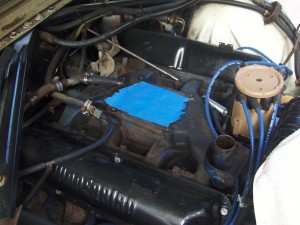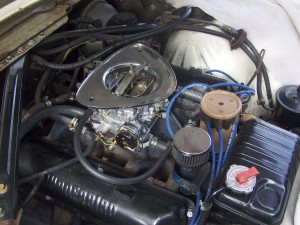These rear brakes are easy to bleed. I spent more time getting my creaky old body under the car than I did actually getting the brakes bled out. When they were ready to go, we applied the parking brake, put the skirts on and jacked the car down off the ramps it had been sitting on for oh-so-long.

There new heat shield for the carb is about a half inch thick and required longer studs in the manifold. It took a while to unscrew the old studs, cut new ones to length and screw them in, but the rest of the assembly was straightforward.
In the process, I noticed that the fuel line was touching the block or manifold in a couple of places, so I lengthened the line and re-routed it to avoid heat sources. I also ditched the the good looking banjo-style fuel inlet line (which forced the fuel line right down next to the manifold) and the in-line fuel pressure gauge (a heavy brass unit, resting on the block and transferring heat into the fuel system).
A quick test drive around the block revealed that the fender skirts rub slightly on the tires during turns. Otherwise, the car started, ran and stopped fine. I believe I can grind down the lip of the skirt a bit for additional clearance. For now, they are living in the trunk.

The brake pedal still travels an awful long way towards the floor before engaging, but the brakes stop the car securely nevertheless. I proved this satisfactorily after getting cut off in traffic a couple of times today. (Seriously? It’s a car as big as a whale; you can’t miss it!) Further proof came at a couple of suddenly-it’s-yellow! stop lights.
Best yet, the car seemed to run stronger and freer than ever, and my odd “dragging” sensation appears to be gone. I still suspect that the right rear brake has been dragging a bit with those wrong-sized springs. Final proof will come when I get the car out onto the freeway later this week. The other culprit could have been a small vacuum leak under the carburetor water jacket: I found two very old gaskets in there.
Despite the good news, there is one pressing mystery, a whistle from under the hood when the gas pedal is partially depressed–just at a certain spot. I’m not sure what it is, but it must be related to the carburetor. It’s a pretty loud noise, and went from odd to irritating to positively annoying in the space of a 5 minute drive. Needs fixed, and pronto.
